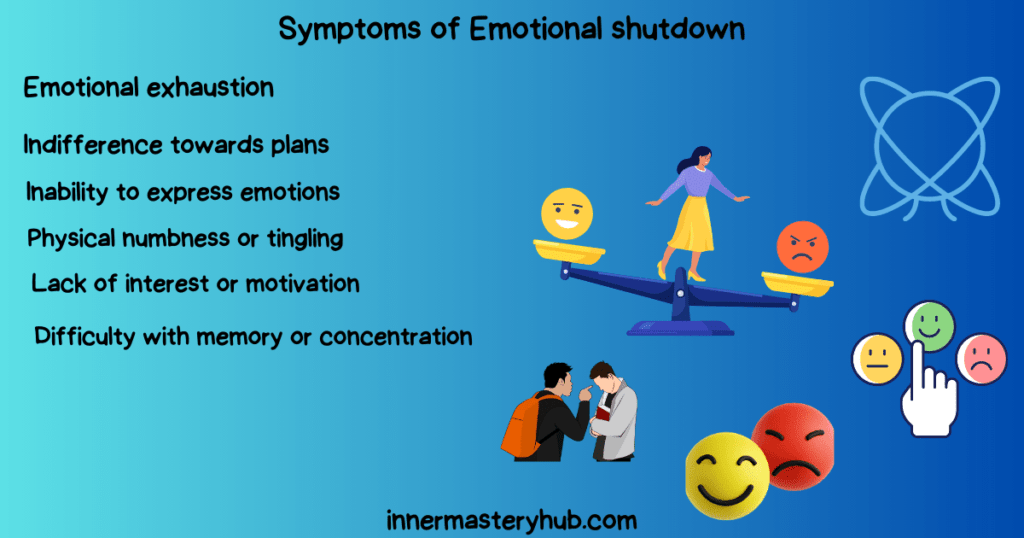Emotional Shut Down: 6 ways to Avoid During Arguments

Has there ever been a day when your heart wanted to hide and curl up? When everything around you feels too noisy, demanding, or overpowering, all you want to do is hide away. You have likely had what psychologists refer to as an “emotional shutdown” if this sounds familiar.
This phenomenon is common, even though it is frequently misunderstood, and it has significant ramifications for our relationships and mental health. Thus, let’s explore what it is, why it occurs, and—above all—how we can more effectively negotiate these emotional waters.
What is an Emotional Shutdown?
A person who suppresses their emotions, effectively becoming emotionally numb, is said to be emotionally shut down. When the emotional load becomes too much to bear, this frequently occurs as a protective strategy during periods of extreme stress, anxiety, or trauma.
An emotional shutdown, such as stonewalling and dissociation, can manifest in various forms, including social disengagement, reduced communication, or a lack of emotional responses. A person’s mental health and interpersonal connections may suffer from persistent emotional shut down, although it may offer momentary respite.
Physical Manifestation of Emotional Shutdown
Cortisol and adrenaline, the body’s primary stress hormones, play a vital role in emotional Shutdown. While they are essential for short-term stress, chronic emotional shut downs can lead to health issues. Managing emotional Shutdown is crucial for maintaining healthier relationships and preventing adverse health effects associated with chronic stress.
According to a 2016 study that monitored 156 couples for 15 years, the emotional Shutdown was linked to acute musculoskeletal complaints such as backaches, stiff necks, and generalized muscle pains.[3]
Symptoms of Emotional shut down
Signs of emotional shut down in your behavior:
- Individuals who lack an emotional response may struggle to experience happiness, sorrow, or other emotions.
- They may experience a sense of disconnection or detachment as if they are looking at their own lives through a glass wall or from a distance.
- Some people may experience tingling or emotional numbness, which can accompany these physical symptoms.
- Memory or attention issues. Emotional Shutdown can impact cognitive abilities.
- Insufficient enthusiasm or drive. Once enjoyable activities may no longer be as appealing.
- Fatigue, stomachaches, and headaches are common physical complaints that are unclear or inexplicable.
- Feeling emotionally spent all the time is known as emotional tiredness.
- Emotional exhaustion. A persistent feeling of being emotionally drained.
- Lack of interest in plans. They may not be concerned about or predict future occurrences or results.
- Lack of ability to communicate feelings. The inability to convey feelings or emotions when it is usually acceptable.
Emotional Shut Down as A Self-Coping Mechanism
A common self-coping strategy used by the mind to shield oneself from emotional distress or trauma is emotional Shutdown. An emotional shutdown or disconnect is a state in which our brains temporarily turn off our emotions when we are faced with situations that exceed our emotional threshold.
Similar to the body’s natural reaction to danger, this is a fight-or-flight or freeze response.
This emotional disengagement can help us cope with a stressful circumstance immediately, but if it persists over time, it can become troublesome. Frequent emotional shut downs may impair our capacity to establish and sustain good relationships as well as cause many mental health problems, such as anxiety and sadness.
Gaining an understanding of this might be the first step toward building emotional resilience and more useful coping mechanisms.
Why do people get emotionally shut down?
Dysfunctional relationships and interpersonal problems can lead to an emotional shutdown, leaving us feeling irritated, powerless, and alienated. Longing for safety and understanding can result from ongoing conflicts, criticism, or emotional neglect.
For some, certain mental health conditions like depression, anxiety, or personality disorders can make emotional Shutdown more likely. These conditions can make it challenging to process and communicate emotions effectively, intensifying the need to withdraw.
Societal and cultural variables influence the emotional Shutdown. Following these expectations can cause us to suppress our feelings in cultures that view emotional display as a sign of weakness.
It’s crucial to understand the underlying causes of emotional Shutdown. It gives us the confidence to ask for the help we need and create healthy coping mechanisms.
John Gottman’s Theory
Stonewalling, or emotional Shutdown, is one of the “Four Horsemen” that might foretell relationship failure, according to renowned psychologist and relationship specialist John Gottman.
In high-stress or high-conflict circumstances, people turn to emotional Shutdown or numbness as a way to avoid overpowering feelings, according to Gottman. This coping strategy may make the other partner feel rejected and alone, which can intensify the argument.
According to Gottman, self-soothing is the remedy for stonewalling, in which the person experiencing overwhelming emotions takes a moment to de-stress and calm down before rejoining the conversation.
What is Stonewalling?
During difficult conversations or confrontations, stonewalling is a protective communication strategy that is frequently employed. Stonewalling is when someone willfully avoids having a conversation, providing relevant information, or addressing problems.
Avoiding questions, being unresponsive, or giving silent treatment are some examples of how this can appear. Although it’s a typical occurrence in social interactions, if left unchecked, stonewalling can exacerbate disputes and lead to communication breakdown.

Causes of Stonewalling
- Causes of Stonewalling:
- Response to intense conflict or criticism
- Protection mechanism against perceived threats or overwhelm
- A coping mechanism to avoid emotional discomfort
- Relationship dynamics and avoidance of confrontations
- Personal temperament and past experiences
- Coping strategy for individuals with certain personality traits or those who have experienced trauma or rejection
- Influenced by societal norms and expectations, such as self-reliance and stoicism
- Understanding the causes helps in recognizing and seeking appropriate support or intervention.
Often, stonewalling is a behavior adopted during one’s formative years. It could be a strategy witnessed by parental figures to maintain harmony within the family or assert control over family dynamics.
Despite the seemingly intentional and aggressive nature of stonewalling, it’s critical to understand that it’s frequently employed by individuals grappling with powerlessness or low self-esteem.
Stonewalling might serve as a coping mechanism in these cases, providing an avenue for compensating for such feelings.
Emotional Shut down in Arguments
Emotional shut down during arguments can take various forms:
- Conversational Disengagement
- Defensive Shutdown
- Aggressively Shutdown
- Indifferent Shutdown
- Manipulative Shutdown
1. Conversational Disengagement
When someone withdraws from a conversation, limits their participation, or avoids meaningful interaction during a discussion, this is referred to as conversational disengagement.
Often used as a coping mechanism during complex or awkward interactions, this practice can hinder communication and make it more challenging to resolve issues.
Examples
- Silent Treatment. When someone replies to a discussion or argument by remaining silent and declining to add anything more, it’s a typical example of conversational disengagement.
- Ignoring. This shows that you are not interested in or concerned about the conversation, as well as failing to acknowledge the other person’s words or inquiries.
- Physical Disengagement. When someone physically leaves the conversation, such as by turning away or leaving the room, this is known as physical disengagement.
- Changing the Subject. Here, the person purposefully changes the subject of the discussion to avoid bringing up the current problem or disagreement.
- Using Electronic Devices. A person may indicate that they are not interested in the current conversation by focusing on electronic gadgets, such as laptops or smartphones.
2. Defensive Shutdown
When someone becomes extremely defensive and refuses to hear the other side of an argument or conversation, it’s known as a defensive shutdown. When people feel attacked or criticized, they often resort to this self-defense technique, which can prevent candid and constructive dialogue.
Examples:
- Denial. This entails flatly rejecting the reality of a problem or issue. Any attempt at resolution is thwarted by the person’s refusal to acknowledge the situation.
- Deflection. Deflection occurs when someone places the blame on someone or something else rather than addressing the problem directly. This evades accountability and may lead to more disputes.
- Rationalization. In this case, the person rationalizes their behavior or actions rather than considering the thoughts or feelings of others. They come up with rational, if frequently false, justifications for their actions.
- Counter-attack. This is launching an attack of one’s own in retaliation for a perceived attack. Instead of confronting the problem, the individual retaliates, intensifying the dispute.
- Victimizing Self. When someone pretends to be a victim to deflect criticism and attention away from their own behavior, this is known as self-victimization.
4. Aggressive Shutdown
An aggressive shutdown is when someone uses hostile behaviors or methods to conclude a discussion or dispute abruptly. Anger, frustration, or an inability to adequately express one’s thoughts and feelings are frequently the root causes. This method exacerbates disputes and destroys relationships by hindering candid and constructive conversations.
Examples
- Yelling. Yelling is a typical form of aggressive Shutdown, in which a person raises their voice to a deafening level. In addition to intimidating the other person into quiet, this is frequently used to vent rage or irritation.
- Sarcasm. In this instance, the person exhibits passive-aggressive behavior by undermining the other person’s point of view through sarcastic comments or humor.
- Over-Talk. When one side talks nonstop without allowing the other to speak, they are engaging in an aggressive shutdown that effectively silences their viewpoint.
- Sarcastic, disparaging, or dismissive remarks that minimize the other person’s viewpoint, emotions, or worries are known as dismissive remarks.
- Threats. To abruptly end the conversation, the person may use threats or other forms of intimidation in severe situations.
5. Indifferent Shutdown
The term “indifferent shutdown” describes the act of emotionally removing oneself from a discussion or dispute, demonstrating a lack of interest or care for the subject or the feelings of the other person. This can be a protective tactic to avoid awkward situations or conflict, but it can also be interpreted as a lack of respect or empathy, which impedes constructive dialogue.
Examples
- Disinterest. The person may act casually or fail to answer correctly, demonstrating a lack of apparent interest in the discussion. This could be interpreted as condescending or heartless.
- Generic or straightforward responses. Examples of superficial Shutdown include phrases such as “whatever” or “I don’t care,” which show a lack of interest or commitment to finding a solution.
- Closed-off body language. Crossed arms or averted looks can be used by someone to indicate that they are not interested in the conversation.
- Monosyllabic Responses. Providing succinct, one-word responses is another typical manifestation of indifference. Such answers stifle in-depth conversation and project disinterest.
- Unresponsive or delayed communication occurs when someone fails to respond to inquiries promptly or at all, conveying a lack of interest.
6. Manipulative Shutdown
The use of manipulative strategies to steer a discussion or argument is known as “manipulative shut down.” To change views, escape accountability, or obtain an unfair advantage entails dishonest or exploitative behavior to sway the conversation in a particular direction. This strategy can damage communication relationships by encouraging distrust and animosity.
EXAMPLES
- By making someone doubt their memory, perception, or sanity, gaslighting is a manipulative technique that shifts the subject of the conversation.
- When someone is guilty-tripping, they try to control or sway the discourse. By implying that the other person is making them unhappy or disappointed, they may divert attention away from the real problem.
- When someone manipulates, threatens, or utilizes their own emotions to coerce another person into agreeing to their demands, this is known as emotional blackmail.
- Playing Dumb. This occurs when someone acts as though they don’t comprehend the problem in order to avoid discussing or addressing it.
- Changing the subject of a conversation or fabricating information to support one’s position is known as diverting and distorting, and it can steer a discussion in the wrong direction.
Emotional Shut down As a Barrier to Self-Growth
An emotional shutdown may seriously hinder personal development. It prevents people from understanding themselves, interferes with constructive dialogue, and limits their capacity to establish and preserve satisfying relationships.
When someone regularly uses emotional Shutdown as a coping strategy, they may become caught in a vicious circle of ineffective behavior. Stasis may result in obstructing any significant emotional or personal development.
Also, if left untreated, ineffective emotional expression or management can result in elevated stress, anxiety, and mental health problems. Overcoming emotional Shutdown promotes resilience, emotional intelligence, and general personal development.
Overcoming Emotional Shutdown: Steps and Strategies
Effective communication, self-awareness, and comprehension are essential for overcoming emotional Shutdown. The following actions and tactics are listed:
Being self-aware means knowing when you are about to shut down emotionally. Be aware of physical indicators, such as an elevated heart rate or a feeling of overwhelm. Recognizing these emotions may be the first step in dealing with them.
Identify the underlying problems or experiences that contribute to an emotional shutdown to understand the root cause. This might be the result of unsolved disputes or past tragedies.
Practicing mindfulness can help you control your immediate emotional reaction to Shutdown. Mindfulness practices include deep breathing and meditation. It can also have a relaxing effect, which makes it easier to make decisions.
Express Feelings Constructively. Try to communicate your thoughts and feelings in an honest, open, and constructive way, rather than resorting to shutdown habits. Using “I” phrases to convey your emotions without placing blame on others may be one way to do this.
Seek expert Assistance. Consulting a mental health expert, such as a therapist, may be helpful if the emotional Shutdown is substantially disrupting your relationships or causing you significant discomfort. To overcome these obstacles, they can offer direction, therapeutic techniques, and assistance.
Frequently Asked Questions
Q.1 Is shutting off a coping mechanism?
Yes, emotional Shutdown or shutting off can be a coping mechanism. It’s a protective response triggered by the brain during overwhelming or distressing situations, shielding the individual from further emotional distress. This ‘freeze’ response helps to navigate through intense emotional states.
Q.2 Is shutting down a trauma response?
Yes, shutting down can indeed be a trauma response. This is often a Survival mechanism that the brain uses to protect the individual from overwhelming or distressing emotions associated with a traumatic experience. It’s part of the body’s “fight, flight, or freeze” response, with ‘shutting down’ falling under the ‘freeze’ category. This means entering a state of emotional numbness or detachment to avoid further harm.
Q.3 Why do I shut down emotionally during arguments?
As a defensive response to avoid immediate emotional discomfort or perceived conflict, this reaction can stem from fear of confrontation, unresolved past traumas, or difficulties in expressing emotions effectively. It serves as a self-protective measure to shield oneself from further emotional distress.
Q.4 What is the 3-day rule after an argument?
The 3-day rule suggests allowing three days after a significant disagreement before discussing the issue again. This time will enable emotions to cool down, gain perspective, and reflect on behavior. However, it’s important to note that the ‘right’ time to revisit the conversation may vary. What matters is that both parties feel ready for a calm, constructive discussion.
Q.5 What to do when someone shuts down in an argument?
When someone shuts down in an argument, remaining calm and patient is crucial. Encourage open communication, expressing that their perspective is valued. Give them space if needed, and revisit the conversation when emotions have subsided. Offering reassurance and empathy can help in re-establishing dialogue.
Q.6 What causes stonewalling?
Stonewalling often arises from fear, discomfort, or a desire to avoid conflict, leading to withdrawal and non-responsive behavior; instead, ask open-ended questions to avoid conflict.
Q.7 Why do I shut down during an argument?
During an argument, you may shut down as a defensive mechanism to protect yourself from potential conflict or emotional discomfort. This can be due to fear of confrontation, unresolved past traumas, or difficulty effectively expressing your emotions, resulting in a retreat into emotional withdrawal.
References
- https://www.frontiersin.org/articles/10.3389/fpsyg.2015.01534/full
- Fischer DJ, Fink BC. Clinical processes in behavioral couples therapy. Psychotherapy (Chic). 2014;51(1):11-4. doi:10.1037/a0033823(opens in a new tab)Fischer DJ, Fink BC. Clinical processes in behavioral couples therapy. Psychotherapy (Chic). 2014;51(1):11-4. doi:10.1037/a0033823
- Haase CM, Holley SR, Bloch L, Verstaen A, Levenson RW. Interpersonal emotional behaviors and physical health: A 20-year longitudinal study of long-term married couples. Emotion. 2016;16(7):965-977. doi:10.1037/a0040239(opens in a new tab)Haase CM, Holley SR, Bloch L, Verstaen A, Levenson RW. Interpersonal emotional behaviors and physical health: A 20-year longitudinal study of long-term married couples. Emotion. 2016;16(7):965-977. doi:10.1037/a0040239






